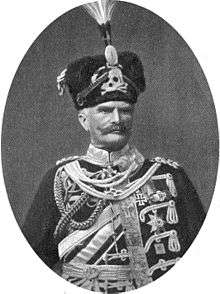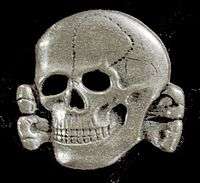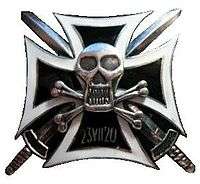Totenkopf

Totenkopf (i.e. skull, literally dead's head) is the German word for the skull and crossbones and death's head symbols. The Totenkopf symbol is an old international symbol for death, the defiance of death, danger, or the dead, as well as piracy. It consists usually of the human skull with or without the mandible and often includes two crossed long-bones (femurs), most often depicted with the crossbones being behind some part of the skull.
It is commonly associated with 19th- and 20th-century German military use.
Etymology
Toten-Kopf translates literally to "dead's head", meaning exactly "dead person's head". Semantically, it refers to a skull, literally a Schädel. As a term, Totenkopf connotes the human skull as a symbol, typically one with crossed thigh bones as part of a grouping.
Contemporary German language meaning of the word Totenkopf has not changed for at least two centuries. For example, the German poet Clemens Brentano (b. 1778 – d. 1842) wrote in the story "Baron Hüpfenstich":
"Lauter Totenbeine und Totenköpfe, die standen oben herum ..."[1] (i.e. "A lot of bones and skulls, they were placed above ...").
The common translation of "Totenkopf" as death's head is incorrect; it would be Todeskopf, but no such word is in use. The English term death squad is called Todesschwadron, not Totenschwadron. It would be a logical fallacy to conclude that usage varies only because of the German naming of the Death's-head Hawkmoth, which is called Skull Hawkmoth (Totenkopfschwärmer) in German, in the same way that it would be a fallacy to conclude that the German word Nachtkerze (i.e. night candle) would mean Willowherb, just because the Willowherb Hawkmoth (Proserpinus proserpina) is called Night Candle Hawkmoth (Nachtkerzenschwärmer, Proserpinus proserpina) in German.
German military
Prussia

Use of the Totenkopf as a military emblem began under Frederick the Great, who formed a regiment of Hussar cavalry in the Prussian army commanded by Colonel von Ruesch, the Husaren-Regiment Nr. 5 (von Ruesch). It adopted a black uniform with a Totenkopf emblazoned on the front of its mirlitons and wore it on the field in the War of Austrian Succession and in the Seven Years' War.
The Totenkopf remained a part of the uniform when the regiment was reformed into Leib-Husaren Regiments Nr.1 and Nr.2 in 1808. When Frederick William, Duke of Brunswick-Wolfenbüttel, was killed in battle during the Napoleonic Wars, his troops changed their uniform colors to black or apple green, with a Totenkopf on their shakos in mourning their dead leader. Other sources claim that the "Black Brunswickers" were so equipped while Friedrich Wilhelm of Brunswick lived, as a sign of revenge on the French.[2]
The skull continued to be used throughout the Prussian and Brunswick Armed forces until 1918, and some of the stormtroopers that led the last German offensives on the Western Front in 1918 used skull badges.[3]
Luftstreitkräfte fighter pilots Georg von Hantelmann[4] and Kurt Adolf Monnington[5] are just two of a number of Central Powers military pilots who used the Totenkopf as their personal aircraft insignia.
Weimar Republic
The Totenkopf was used in Germany throughout the inter-war period, most prominently by the Freikorps. In 1933, it was in use by the regimental staff and the 1st, 5th, and 11th squadrons of the Reichswehr's 5th Cavalry Regiment as a continuation of a tradition from the Kaiserreich.
Third Reich



In the early days of the NSDAP, Julius Schreck, the leader of the Stabswache (Adolf Hitler's bodyguard unit), resurrected the use of the Totenkopf as the unit's insignia. This unit grew into the Schutzstaffel (SS), which continued to use the Totenkopf as insignia throughout its history. According to a writing by Reichsführer-SS Heinrich Himmler the Totenkopf had the following meaning:
The Skull is the reminder that you shall always be willing to put your self at stake for the life of the whole community.[6]
The Totenkopf was also used as the unit insignia of the Panzer forces of the German Heer (Army), and also by the Panzer units of the Luftwaffe, including those of the elite Fallschirm-Panzer Division 1 Hermann Göring.[7]
Both the 3rd SS Panzer Division of the Waffen-SS, and the World War II era Luftwaffe's 54th Bomber Wing Kampfgeschwader 54 were given the unit name "Totenkopf", and used a strikingly similar-looking graphic skull-crossbones insignia as the SS units of the same name. The 3rd SS Panzer Division also had skull patches on their uniform collars instead of the SS sieg rune.
Non-German military



- A skull and crossbones has often been a symbol of pirates, especially in the form of the Jolly Roger, but usually having the crossbones beneath the skull rather than behind it, as used by pirate Samuel Bellamy in one example.
- The Italian elite storm-troopers of the Arditi used a skull with a dagger between its teeth as a symbol during World War 1. Various versions of skulls were also later used by the Italian Fascists.
- The British Army's Royal Lancers continue to use the skull and crossbones in their emblem, inherited from its use by the 17th Lancers, a unit raised in 1759 following General Wolfe's death in Quebec. The emblem contains an image of a death's head, and the words 'Or Glory', chosen in commemoration of Wolfe.[8]
- In 1792, a regiment of Hussards de la mort (Death Hussars) was formed to defend the young French Republic from the Austrian attempt to invade France.[9]
- South Korea's 3rd Infantry Division (백골부대) have a skull-and-crossbones in their emblem.
- The primarily Prussian 41st Regiment New York Volunteer Infantry, Mustered in: June 6, 1861-Mustered out: December 9, 1865 wore a skull insignia.[10]
- The Portuguese Army Police 2nd Lancers Regiment use a skull-and-crossbones image in their emblem, similar to the one used by the Queen's Royal Lancers.
- The Kingdom of Sweden's Hussar Regiments wore a death's head emblem in the Prussian Style on the front of the mirleton.
- Ramón Cabrera's regiment adopted in 1838 a skull with crossbones flanked by an olive branch and a sword on a black flag during the Spanish Carlist Wars.
- The White Russian Kornilov regiment adopted a death's head emblem in 1917.
- The Estonian Kuperjanov's Partisan Battalion used the skull-and-crossbones as their insignia (since 1918); the Kuperjanov Infantry Battalion continues to use the skull and crossbones as their insignia today.
- Two Polish small cavalry units used death's head emblem during Polish–Ukrainian War and Polish–Soviet War - Dywizjon Jazdy Ochotniczej (also known as Huzarów Śmierci i.e. Death Hussars) and Poznański Ochotniczy Batalion Śmierci.
- During 1943-1945 the Italian Black Brigades and numerous other forces fighting for the Italian Social Republic, wore various versions of skulls on their uniforms, berets, and caps.
- Although not exactly a Totenkopf per se, the Chilean guerrilla leader Manuel Rodríguez used the symbol on his elite forces called "Husares de la muerte" ("Hussars of death"). It is still used by the Chilean Army's 3rd Cavalry Regiment.
- The United States Marine Corps Reconnaissance Battalions use the skull-and-crossbones symbol in their emblem.
- The No. 100 Squadron RAF (Royal Air Force) continue to use a flag depicting a skull and crossbones supposedly in reference to a flag stolen from a French brothel in 1918.
- The Batalhão de Operações Policiais Especiais, a special unit within the military police of Rio de Janeiro state, Brazil, uses the skull emblem to differentiate their team from the regular units.
- Many United States Cavalry reconnaissance troops or squadrons utilize a skull insignia, often wearing the traditional Stetson hat, and backed by either crossed cavalry sabers, crossed rifles, or some other variation, as an unofficial unit logo. These logos are incorporated in to troop T-shirts, challenge coins, or other items designed to enhance morale and esprit de corps.
Commercial
- Craft International logo, military training company founded by Chris Kyle[11][12]
Other uses
In the United States, the skull & crossbones symbol has often been used to indicate a poisonous substance.
See also
- 3rd SS Division Totenkopf
- Fascist symbolism
- Human skull symbolism
- Kampfgeschwader 54
- Jolly Roger
- Kuperjanov Battalion
- Memento Mori
- Skull and Bones
- SS-Totenkopfverbände
Bibliography
- Klaus D. Patzwall: Der SS-Totenkopfring. 5th edition: Patzwall, Melbeck 2010, ISBN 978-3-931533-07-6.
- Joost Hølscher (Author, Illustrator): Death's Head, The History of the Military Skull & Crossbones Badge (The History of Uniform). 1st edition: Éditions Chamerelle 2013, ISBN 978-90-820326-0-4
References
- ↑ Clemens Brentano: Baron Hüpfenstich - Chapter 2 (Projekt Gutenberg-DE)
- ↑ Osprey Publishing - The Black Brunswickers
- ↑ First World War - Willmott, H. P.; Dorling Kindersley, 2003, Page 252
- ↑ Georg von Hantelmann & Kurt Wüsthoff's Fokker D.VII, Jasta 15
- ↑ van Wyngarden, Greg (2011). Osprey Elite Aviation Units #40: Jasta 18 - The Red Noses. Oxford UK: Osprey Publishing. pp. 85–86, 97. ISBN 978-1-84908-335-5.
- ↑ Heinrich Himmler: "Der Totenkopf ist die Mahnung, jederzeit bereit zu sein, das Leben unseres Ichs einzusetzen für das Leben der Gesamtheit."
- ↑ Angolia, John R., and Adolf Schlicht, Uniforms and Traditions of the Luftwaffe Volume 2, R. James Bender Publishing, San Jose, CA, 1997. ISBN 0-912138-71-8.
- ↑ QRL Regimental Association
- ↑ (French) http://pagesperso-orange.fr/minismodels/figurines/hussards_de_la_mort/hussards_de_la_mort.htm
- ↑ "New York State Military Museum and Veterans Research Center - Welcome".
- ↑ http://www.thecraft.com/craft_skull.html
- ↑ "craft internationallogo - Google Search".